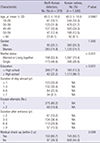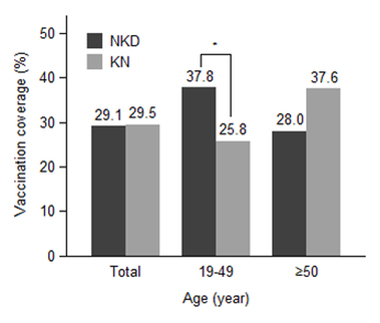1. Noland M, Robinson S, Wang T. Famine in North Korea: Causes and Cures. Econ Dev Cult Change. 2001; 49:741–767.
3. Lee Y, Lee MK, Chun KH, Lee YK, Yoon SJ. Trauma experience of North Korean refugees in China. Am J Prev Med. 2001; 20:225–229.
4. Jeon W, Hong C, Lee C, Kim DK, Han M, Min S. Correlation between traumatic events and posttraumatic stress disorder among North Korean defectors in South Korea. J Trauma Stress. 2005; 18:147–154.
5. Park SM. Primary health care for vulnerable population. Korean J Fam Med. 2009; 30:91–97.
6. World Health Organization. Report No.: WHA61/2008/REC/1. Sixty-first world health assembly: resoutions and decisions annexes. Geneva: World Health Organization;2008. p. 23–25.
7. Nicholson KG, Wood JM, Zambon M. Influenza. Lancet. 2003; 362:1733–1745.
8. Endrich MM, Blank PR, Szucs TD. Influenza vaccination uptake and socioeconomic determinants in 11 European countries. Vaccine. 2009; 27:4018–4024.
9. Nichol KL. Cost-benefit analysis of a strategy to vaccinate healthy working adults against influenza. Arch Intern Med. 2001; 161:749–759.
10. Blank PR, Schwenkglenks M, Szucs TD. Influenza vaccination coverage rates in five European countries during season 2006/07 and trends over six consecutive seasons. BMC Public Health. 2008; 8:272.
11. World Health Organization. Report No.: WHA56.19. Prevention and control of influenza pandemics and annual epidemics. Geneva: World Health Organization;2003.
13. Ministry of Health and Welfare, Korea Centers for Disease Control and Prevention. Korea Health Statistics 2012: Korea National Health and Nutrition Examination Survey (KNHANES V-3). Cheongwon: Korea Centers for Disease Control and Prevention;2013.
14. Jiménez-García R, Hernández-Barrera V, Carrasco-Garrido P, López de Andrés A, Pérez N, de Miguel AG. Influenza vaccination coverages among children, adults, health care workers and immigrants in Spain: related factors and trends, 2003-2006. J Infect. 2008; 57:472–480.
15. Rodriguez-Rieiro C, Hernández-Barrera V, Carrasco-Garrido P, de Andres AL, Jiménez-García R. Vaccination against 2008/2009 and 2009/2010 seasonal influenza in Spain: coverage among high risk subjects, HCWs, immigrants and time trends from the 2005/2006 campaign. Vaccine. 2011; 29:6029–6034.
16. Carrasco-Garrido P, Jiménez-García R, Barrera VH, de Andrés AL, de Miguel AG. Significant differences in the use of healthcare resources of native-born and foreign born in Spain. BMC Public Health. 2009; 9:201.
17. Petersen RL, Saag K, Wallace RB, Doebbeling BN. Influenza and pneumococcal vaccine receipt in older persons with chronic disease: a population-based study. Med Care. 1999; 37:502–509.
18. Kamal KM, Madhavan SS, Amonkar MM. Determinants of adult influenza and pneumonia immunization rates. J Am Pharm Assoc (2003). 2003; 43:403–411.
19. Kohlhammer Y, Schnoor M, Schwartz M, Raspe H, Schäfer T. Determinants of influenza and pneumococcal vaccination in elderly people: a systematic review. Public Health. 2007; 121:742–751.
20. Johnson DR, Nichol KL, Lipczynski K. Barriers to adult immunization. Am J Med. 2008; 121:S28–S35.
21. Szucs TD, Müller D. Influenza vaccination coverage rates in five European countries-a population-based cross-sectional analysis of two consecutive influenza seasons. Vaccine. 2005; 23:5055–5063.
22. Müller D, Nguyen-Van-Tam JS, Szucs TD. Influenza vaccination coverage rates in the UK: a comparison of two monitoring methods during the 2002-2003 and 2003-2004 seasons. Public Health. 2006; 120:1074–1080.
23. Kouides RW, Bennett NM, Lewis B, Cappuccio JD, Barker WH, LaForce FM. Performance-based physician reimbursement and influenza immunization rates in the elderly. The Primary-Care Physicians of Monroe County. Am J Prev Med. 1998; 14:89–95.
24. Promote Vaccinations among Migrant Populations in Europe. Migrant immunization policies, legislation and practices in the hosting countries. Promovax project. 2010. accessed on 4 July 2015. Available at
http://www.promovax.eu/pdfs/HOSTING_COUNTRIES.pdf.
25. Lee HY, Gerber J. 'We Just Do What We Think Is Right. We Just Do What We Are Told:'Perceptions of Crime and Justice of North Korean Defectors. Asia Pac J Police Crim Justice. 2009; 7:21–48.
26. Yoon IJ. North korean diaspora: north korean defectors abroad and in South Korea. Dev Soc. 2001; 30:1–26.
27. Zimmerman RK, Raymund M, Janosky JE, Nowalk MP, Fine MJ. Sensitivity and specificity of patient self-report of influenza and pneumococcal polysaccharide vaccinations among elderly outpatients in diverse patient care strata. Vaccine. 2003; 21:1486–1491.







 PDF
PDF ePub
ePub Citation
Citation Print
Print




 XML Download
XML Download